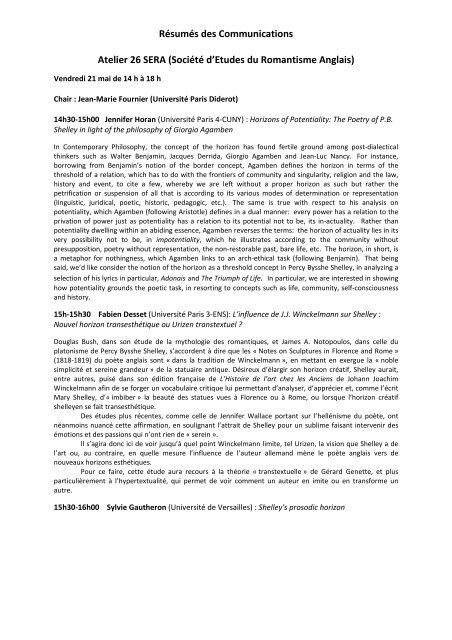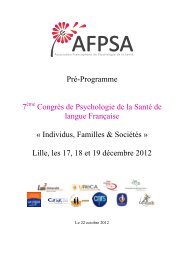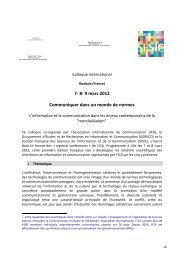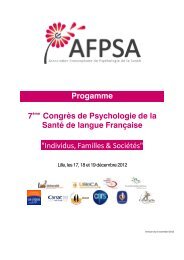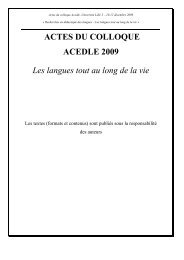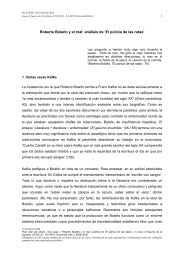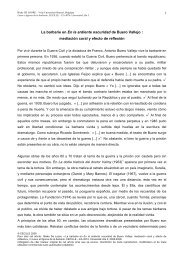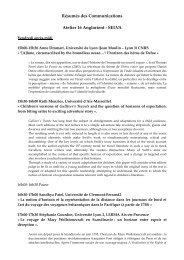Résumés des communications Atelier SERA 26.rtf - Lille 3
Résumés des communications Atelier SERA 26.rtf - Lille 3
Résumés des communications Atelier SERA 26.rtf - Lille 3
You also want an ePaper? Increase the reach of your titles
YUMPU automatically turns print PDFs into web optimized ePapers that Google loves.
<strong>Résumés</strong> <strong>des</strong> Communications<br />
<strong>Atelier</strong> 26 <strong>SERA</strong> (Société d’Etu<strong>des</strong> du Romantisme Anglais)<br />
Vendredi 21 mai de 14 h à 18 h<br />
Chair : Jean-Marie Fournier (Université Paris Diderot)<br />
14h30-15h00 Jennifer Horan (Université Paris 4-CUNY) : Horizons of Potentiality: The Poetry of P.B.<br />
Shelley in light of the philosophy of Giorgio Agamben<br />
In Contemporary Philosophy, the concept of the horizon has found fertile ground among post-dialectical<br />
thinkers such as Walter Benjamin, Jacques Derrida, Giorgio Agamben and Jean-Luc Nancy. For instance,<br />
borrowing from Benjamin’s notion of the border concept, Agamben defines the horizon in terms of the<br />
threshold of a relation, which has to do with the frontiers of community and singularity, religion and the law,<br />
history and event, to cite a few, whereby we are left without a proper horizon as such but rather the<br />
petrification or suspension of all that is according to its various mo<strong>des</strong> of determination or representation<br />
(linguistic, juridical, poetic, historic, pedagogic, etc.). The same is true with respect to his analysis on<br />
potentiality, which Agamben (following Aristotle) defines in a dual manner: every power has a relation to the<br />
privation of power just as potentiality has a relation to its potential not to be, its in-actuality. Rather than<br />
potentiality dwelling within an abiding essence, Agamben reverses the terms: the horizon of actuality lies in its<br />
very possibility not to be, in impotentiality, which he illustrates according to the community without<br />
presupposition, poetry without representation, the non-restorable past, bare life, etc. The horizon, in short, is<br />
a metaphor for nothingness, which Agamben links to an arch-ethical task (following Benjamin). That being<br />
said, we’d like consider the notion of the horizon as a threshold concept in Percy Bysshe Shelley, in analyzing a<br />
selection of his lyrics in particular, Adonais and The Triumph of Life. In particular, we are interested in showing<br />
how potentiality grounds the poetic task, in resorting to concepts such as life, community, self-consciousness<br />
and history.<br />
15h-15h30 Fabien Desset (Université Paris 3-ENS): L’influence de J.J. Winckelmann sur Shelley :<br />
Nouvel horizon transesthétique ou Urizen transtextuel ?<br />
Douglas Bush, dans son étude de la mythologie <strong>des</strong> romantiques, et James A. Notopoulos, dans celle du<br />
platonisme de Percy Bysshe Shelley, s’accordent à dire que les « Notes on Sculptures in Florence and Rome »<br />
(1818-1819) du poète anglais sont « dans la tradition de Winckelmann », en mettant en exergue la « noble<br />
simplicité et sereine grandeur » de la statuaire antique. Désireux d’élargir son horizon créatif, Shelley aurait,<br />
entre autres, puisé dans son édition française de L’Histoire de l’art chez les Anciens de Johann Joachim<br />
Winckelmann afin de se forger un vocabulaire critique lui permettant d’analyser, d’apprécier et, comme l’écrit<br />
Mary Shelley, d’« imbiber » la beauté <strong>des</strong> statues vues à Florence ou à Rome, ou lorsque l’horizon créatif<br />
shelleyen se fait transesthétique.<br />
Des étu<strong>des</strong> plus récentes, comme celle de Jennifer Wallace portant sur l’hellénisme du poète, ont<br />
néanmoins nuancé cette affirmation, en soulignant l’attrait de Shelley pour un sublime faisant intervenir <strong>des</strong><br />
émotions et <strong>des</strong> passions qui n’ont rien de « serein ».<br />
Il s’agira donc ici de voir jusqu’à quel point Winckelmann limite, tel Urizen, la vision que Shelley a de<br />
l’art ou, au contraire, en quelle mesure l’influence de l’auteur allemand mène le poète anglais vers de<br />
nouveaux horizons esthétiques.<br />
Pour ce faire, cette étude aura recours à la théorie « transtextuelle » de Gérard Genette, et plus<br />
particulièrement à l’hypertextualité, qui permet de voir comment un auteur en imite ou en transforme un<br />
autre.<br />
15h30-16h00 Sylvie Gautheron (Université de Versailles) : Shelley's prosodic horizon
Chair : Joanny Moulin (Aix-Marseille)<br />
16h15-16h45 Madhu Benoit (Université Grenoble 3) : Opening New ‘Horizons’ : Sir William Jones<br />
Ushers in the Romantic Sublime<br />
Though the founder of indology – Sir William Jones – cannot possibly be considered in the character of the<br />
‘Romantic Rebel’, he nevertheless opened new horizons of the imagination for a classical eighteenth century<br />
Europe. In his book The Mirror and the Lamp, M. H. Abrams notes how Jones deliberately breaks with neoclassical<br />
theories of poetry in his ‘Essay on the Arts Called Imitative’ (1772). Jones not only challenges the<br />
neoclassical doctrine that mimetic art was superior to both creativity and originality, refuting Aristotle’s famous<br />
assertion: “all poetry consists in imitation” (Works X:361) he places the artist’s power to affect the imagination<br />
at the centre of creativity : “Thus will each artist gain his end, not by imitating the works of nature, but by<br />
assuming her power, and causing the same effect upon the imagination, which her charms produce to the<br />
senses”. (Works X:361) We are closer to Shelley’s famous ‘fading coal’ image than to Pope here. Jones’s<br />
experiments fascinated an entire generation of European writers rebelling against neo-classical rules.<br />
Exotic new vistas opened up for a European literati steeped in classical mythology, as the early Orientalists<br />
flooded them with translations of Oriental poetry, adding loanwords from Arabic and Sanskrit texts thus<br />
initiating the Romantic poetic tradition of using proper nouns for local colour. Nor was it a mere question of<br />
exotic setting and images, but rather the universally significant experience in the exposure to hitherto<br />
unknown mythologies – Indian or Persian – relating to the Supreme Being and the creation/universe, which<br />
captured European imagination. William Jones was the main purveyor of knowledge of India, influencing the<br />
Romantics, both directly and indirectly. His translation of Jayadeva’s Gita Govinda, a sacred but also graphically<br />
sexual union between Radha, the individual soul, and Krishna, the divine being finds echoes in Shelley’s poetry.<br />
Similarly, Jones’ empathy for the Hindu conception of the non-duality of God and the human soul as explained<br />
by Sankara in his commentary on the Vedanta forms the sub-text for Lady Morgan’s The Missionary.<br />
However, the new horizons tended to be somewhat hazy, and the Orient vaguely perceived as anywhere East<br />
of Greece. The mythical image of India, set somewhere in this haze, haunted the Romantic imagination. An<br />
attempt will be made in this paper to analyse some aspects of the impact of Indian thought and philosophy on<br />
Romantic poetry.<br />
16h45-17h15 Yann Tholoniat (Université de Strasbourg) : Robert Burns et l’idée de contrat naturel.<br />
Le poète Burns, en tant que paysan, manifeste dans ses poèmes une très grande connaissance de la nature, de<br />
la flore comme de la faune. Si cette connaissance peut sembler le résultat d’une pratique empirique de la<br />
nature, il convient de signaler que Burns complétait ce savoir au moyen de différents ouvrages offerts ou<br />
empruntés. Un livre récent consacré aux rapports entre Burns et le monde vivant (John Young, Robert Burns. A<br />
Man for All Seasons. Scottish Cultural Press, Aberdeen, 1996) met en évidence les milliers de références et<br />
d’allusions aux mon<strong>des</strong> végétal et animal qui stimulent l’inspiration poétique de Burns. À l’horizon de l’univers<br />
humain, culturel, et dans la lignée de la polémique rousseauiste, Burns attire l’attention de ses lecteurs sur<br />
l’univers du vivant, subvertissant les limites de l’anthroposphère. Le poète écossais déploie dans ses poèmes<br />
une conscience écologique très aiguë qui prend parfois <strong>des</strong> accents revendicatifs extrêmement virulents. Cette<br />
double perspective du poète et du paysan envers la nature fait de Burns un objet d’étude particulièrement<br />
fascinant dans le cadre d’une perspective éco-critique. Dépassant l’horizon anthropocentriste de nombre de<br />
ses contemporains, Burns insiste à sa manière sur la nécessité d’un écocentrisme permettant aux règnes<br />
humain, végétal et animal de vivre ensemble de façon durable.<br />
17h15-17h45 Samuel Baudry (Université Lyon 2) : Horizons éphémères : les traductions <strong>des</strong><br />
Miscellanies à la fin du 18 ème siècle.<br />
L’horizon est ici à comprendre comme un passé devenu étranger à notre conception post-romantique de la<br />
traduction: un ensemble de pratiques littéraires et sociales autours de textes poétiques étrangers, en italien<br />
moderne autant qu’en latin, qui se sont déployées dans toutes sortes de publications éphémères à la fin du<br />
18 ème siècle en Italie (avec les Della Cruscan, par exemple) et en Grande-Bretagne.<br />
Dans cette communication je voudrais essayer de recouvrer ces genres, ces métho<strong>des</strong>, ces débats détrônés par<br />
les nouveaux procédés et les nouvelles théories qui naissent au 19 ème siècle (le littéralisme et la philologie,<br />
entre autre).<br />
Trois horizons vers lesquels se tourner, qu’il faut reconstituer pour comprendre ce que le Romantisme va<br />
détruire ou renouveler : les communautés anglophones en Italie, où les femmes traductrices occupent le<br />
premier plan ; la constitution d’un canon de textes étrangers modernes ; les traductions qui n’en sont plus<br />
(imitations, réécriture, variations…). Ces dernières, maintenant exclues du champ de la traduction, nous<br />
suggèrent peut-être un nouvel horizon traductologique.
Samedi 22 mai de 9 h à 12 h<br />
Chair : Marc Porée (Université Paris 3)<br />
9h-9h30 Erik Martiny (Lycée International d’Aix en Provence) : The Horizon of the Last Romantic<br />
This paper proposes to take a look at how the neo-romantic English poet Peter Redgrove interacts with some of<br />
the iconic Modernist poems of Wallace Stevens in order to orient Stevens’s Modernism in the direction of<br />
Romanticism.<br />
Although Redgrove began writing at a much later period, around the time when Stevens died, both<br />
poets have been viewed as belated romantics. Indeed Stevens and Dylan Thomas, another of Redgrove’s<br />
forefathers (both died in the fifties when Redgrove was emerging), have often been saluted as iconic figures of<br />
the Last Romantic, to use Yeats’s self-aggrandising phrase. And yet the successive presence of Stevens, Thomas<br />
and Redgrove (among others) shows that there is no such thing as a Last Romantic, that there will always be a<br />
few isolated poets who will draw on the neo-romantic themes of their immediate forefathers.<br />
Neither Stevens nor Redgrove ultimately saw themselves as «last romantics» in the rather<br />
disillusioned sense in which the notion is employed by Yeats. Their most striking tonal characteristics are<br />
relentless exuberance and abiding optimism. While Stevens saw the spiritual importance of fostering a kind of<br />
new romanticism in the 1930s, he possessed none of the eschatological melancholy that Yeats’s combination of<br />
post-fin-de-siècle anxiety and millennial apocalypticism induced. Likewise, Redgrove saw himself as a<br />
perpetuator of romantic values rather than the last bastion of depth and true feeling in a world gone to rack<br />
and ruin.<br />
Within the context of «Last Romanticism» I propose to examine how Redgrove reworks such poems as «The<br />
Idea of Order at Key West» so as to highlight and reformulate its Romantic elements.<br />
9h45-10h15 Sylvia Lemêlé (Université de Caen) : L'expérience de l'imaginaire dans 'The Rime of the<br />
Ancient Mariner'.<br />
Dans la Biographia Literaria, la pensée de Coleridge s’inscrit dans la conception métaphysique et romantique<br />
de la présence d’un arrière monde invisible. La conscience philosophique, intuition transcendantale, donne à<br />
voir au-delà de l’horizon naturel, dans les profondeurs de l’âme. Cette approche plonge ses racines dans « The<br />
Rime of the Ancient Mariner », où le marin, doté d’une conscience réflexive déstructurée en raison de sa perte<br />
de communion avec le monde, n’a qu’une vision partielle. Entre l’empirisme de David Hartley et l’immanence<br />
divine de Berkeley, Coleridge montre comment la restauration de la relation du marin à la surnature s’élabore<br />
autour de la reconquête de l’imaginaire. Il esquisse l’ébauche d’une première théorie de l’inconscient, où la<br />
conscience participative d’une chaîne de relations cosmiques permet, lors de moments suspendus de l’âme, la<br />
libération de l’imaginaire. Force organique occulte, l’imaginaire révèle l’invisible de l’être dans <strong>des</strong> paysages<br />
miroirs, et participe d’une réflexivité transfiguratrice et régénératrice entre le conscient et l’inconscient.<br />
10h30-11h00 Joanny Moulin (Université d’Aix-Marseille) : Remarques sur la vie de S. T. Coleridge<br />
L'histoire de la vie de Coleridge n'a que fort peu favorisé la réception de son œuvre, de son vivant comme aux<br />
yeux de la postérité. Trop souvent, ceux qui écrivent sur Coleridge cèdent à la tentation de dénigrer son<br />
caractère, puis tombent dans le regrettable travers d'une certaine con<strong>des</strong>cendance, aussi infime soit-elle, à<br />
l'égard de ce qu'il a accompli. Cet article ne prétend pas faire être hagiographique, et encore moins<br />
entreprendre une défense évidemment superflue de Coleridge. Certes, l'homme n'était pas sans défauts. Mais<br />
Biographia Literaria fut à bien <strong>des</strong> égards une tentative réussie de se sauver par la littérature. Le génie<br />
particulier de Coleridge était avant tout d'une nature oratoire, qui devait beaucoup à la tradition britannique<br />
<strong>des</strong> prédicateurs laïques dissidents. Sa principale contribution à la littérature, outre un certain nombre de<br />
grands poèmes canoniques composés avec le talent éclairé d'un amateur au plus noble sens du terme, ne fut<br />
pas simplement une vulgarisation de la philosophie idéaliste allemande, mais consista délibérément en une<br />
réconciliation idéologique de la philosophie avec la religion, qui exerça une influence décisive sur l'histoire <strong>des</strong><br />
idées.<br />
11h30-12h00 Caroline Bertonèche (Université Grenoble 3) : "As I lay writing": Le romantisme à<br />
l'horizon(tal) de John Keats<br />
Il s'agit d'explorer l'horizon keatsien dans tout ce qu'il a de lyrique, de critique (cf. Michel Collot) mais aussi de<br />
métapoétique. Keats rejette la verticalité d'un romantisme plus aride mais aussi plus élitiste pour <strong>des</strong> raisons<br />
qui lui sont propres et qui définissent toute l'originalité d'un art "in-fini" qui voit loin, par-delà les limites<br />
physiques et temporelles qui viennent brider les aspirations d'un jeune poète.


